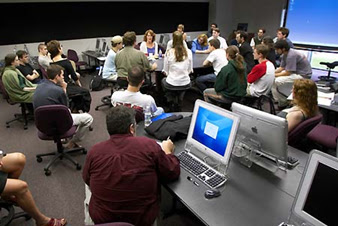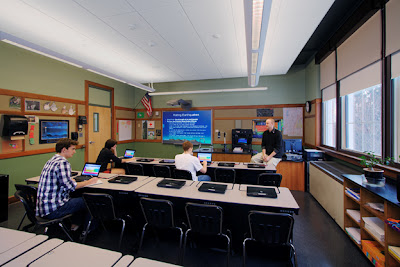Digital Crayon: Article 7 – Technology in Schools
posted by David Epstein, AIA, LEED AP
In our last conversation, we looked at the Learning Commons (aka Library) and started discussing technology. This is a subject worth spending a little more time on. While schools we work with are all increasingly integrating technology into the learning experience, they are all at different parts of the journey. Some have one-to-one laptop programs, some have laptop carts, others a few hardwired computers in each classroom. Some have all of the above!
 A decent percentage of the schools have a technology plan. Like a strategic plan, this plan lays out the school’s goals and approach over a fixed period of time. However, the technology is changing so fast that these plans often become obsolete quickly
A decent percentage of the schools have a technology plan. Like a strategic plan, this plan lays out the school’s goals and approach over a fixed period of time. However, the technology is changing so fast that these plans often become obsolete quickly
Let’s first talk about laptops. The first issue affecting facilities was the need for charging stations. Some schools have carts, others have put outlets in lockers. Recently, we have heard of some schools who put the responsibility on the students to do this at home. This depends of course on battery life. We suspect with the advent of solid state hard drives and longer battery life, this issue will go away.
Laptops generally run on a wireless network. Concern has been raised by some schools about the health effects of wireless technology. As far as we have read, the evidence is not conclusive. However, the concerns are real. Wireless technology can be less reliable than wired networks and can’t support large file transfers as readily.
Laptop carts have become quite popular. This is a mobile cart holding 20-25 laptops that several classes can share. As a result, we have been converting some computer labs back into classroom space. The two areas where this is not possible is with young students (Pre-K, K, 1) and High School video editing labs. The younger kids can’t carry the laptops around easily. Video editing requires fairy robust desktop computers to process the large files.
 This brings us to tablets. To date, we have not seen wide spread adoption of a one-to-one program with a tablet but we are sure it’s coming. With their relatively low cost, low weight and long battery life, they seem a natural for the school environment.
This brings us to tablets. To date, we have not seen wide spread adoption of a one-to-one program with a tablet but we are sure it’s coming. With their relatively low cost, low weight and long battery life, they seem a natural for the school environment.
Many students, especially in high school, own their own device(s) and prefer using them to school issued equipment. As a result, some schools have a BYOD (bring your own device) approach to technology, investing their resources in an infrastructure that allows many types of devices to access the network, digital curriculum and printing options.
In this rapidly evolving environment, the key to a successful approach is flexibility. Focusing on providing the infrastructure to support multiple platforms will help keep the school ready for the next new device. Easy access to power and data outlets, wireless, network resources, internet, printers and most importantly the school’s educational and communication tools are always good investments amidst the changing digital landscape.
Next Article – Article 8 – Sustainability – Coming in two weeks!
Last Article – Article 6 – The Learning Commons